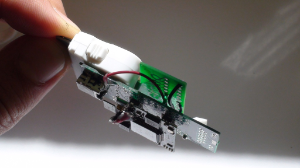openiPhone
We have been looking for a few months at the best way to add an IEEE802.15.4 interface to a smart phone. This article details the steps to do so on a iPhone. Specifically, we use a GINA mote running the OpenWSN stack; the jailbroken iPhone runs Python script which is is part of OpenWSN.
| Center | ||||
|---|---|---|---|---|
|
Step 1: building the hardware
The 30-pin connector on the bottom of the iPhone contains a 3.3V TTL-level UART (2 pins, one Tx, one Rx) as well as a 3.3V and a ground line. The physical interconnection between the iPhone and the GINA mote (or any mote which has a UART link) consists of 4 wires.
...
The GINA mote fits into the male connector of the GINA-breakout.
Step 2: JailBreaking your iPhone
"!JailBreaking" an iPhone modifies its operating system (iOS) and allows it to run applications which have not been previously approved by Apple. It is both reversible and legal in the USA. We require a JailBroken iPhone to be able to interact with the UART link, something which can not be done through iOS. More specifically, iOS does allow you to interact through UART with iPhone accessories, but for those accessories to be recognized by the iPhone, they need to contain an authentication chip provided by Apple. Considering this limited proof-of-concept experiment, we haven't been able to obtain such chips from Apple.
You need your iPhone to run iOS version 4.0.1 or below. To jailbreak it, use your iPhone's browser to navigate to http://jailbreakme.com/, then slide the"slide to jailbreak" slider. The JailBreaking process is completely automated, and takes 5-10 min. Because it involves downloading Linux packages, it's a good idea to have your iPhone connected to a ! WiFi network when you do this. For more information, read http://jailbreakme.com/faq.html.
...
Use Cydia to install the following packages:
OpenSSH
...
- allows you to connect remotely to your iPhone using PuTTY, a text-based Linux equivalent of Windows' remote desktop application
...
- .
- Vi IMproved (
vim) is a simple text editor so you can open files while connected to your iPhone through SSH; PyObjC
...
- is a package which converts Python code you write into Obective C, the C dialest the iPhone understands;
iPhone/Python
...
- is an example Python program written by saurik from UC
...
- Santa Barbara, showcasing the use of PyObjC.
...
Step 3: programming the iPhone
download Download the OpenWSN source code by following the Getting Started tutorial;
the application to run on your iPhone is in the iphonesoftware/iphone/ folder (available in older revisions you can revert to);
using . Using WinSCP, drag-and-drop the OpenWSN.app/ folder folder into the iPhone's /Applications/ folder
to . To refresh the springboard and have the Cal logo show (see picture above), log into to your iPhone using PuTTY, switch to user "mobile" and type "uicache" mobile and type uicache.
Step 4: running the application
This application allows you to remote-control a helicopter controlled by a GINA mote running the OpenWSN stack. In particular, it sends UDP packets to the application Heli which listens to UDP port 2192.
This application expects 4 bytes of payload:
- the first 2 bytes represent a 16-bit unsigned integer (
...
- big-endian) which controls speed of the upper rotor.
...
- the second 2 bytes control the speed of the lower rotor.
The higher the number, the faster the rotor, with a maximum value of 100. A value 0 stops the rotor.
...
The graphical interface consists of 3 sliders:
- the top one for the top rotor
...
- .
- the lowest for the lower rotor
...
- .
- the center slider to control both rotors at the same time.
Once you connect the hardware, moving the position of a slider causes a UDP packet to be sent to the IP IPv6 address of the helicopter, which sets its rotors accordingly.
In the YouTube video above, the projector screen shows the stream of packets which travel over the air, captured using Wireshark.
Please direct questions to Thomas Watteyne.

